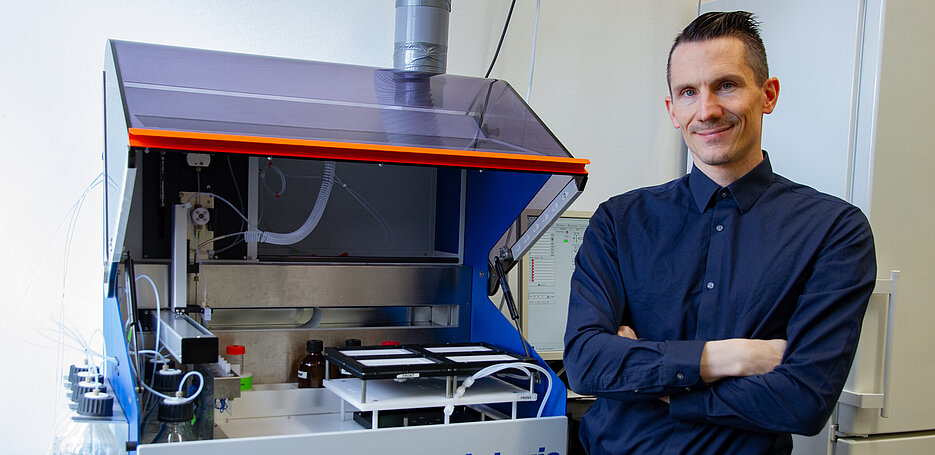New neuropharmacological approach
03/19/2021Dr. Hans Maric has received one of the German Research Foundation's highly prestigious Emmy Noether awards, worth around 1.7 million euros. He will use his biochip technology to study a so far unexplored group of brain proteins and determine their potential to cure so far untreatable mental diseases.
Dysfunctional nerve cell proteins are thought to underlie a large number of mental disorders. The involved proteins and their specialized tasks remain largely unexplored, rendering a targeted therapy impossible. Dr. Hans Maric of the Rudolf Virchow Center for Integrative and Translational Bioimaging at the University of Würzburg wants to use his biochip technology to explore the proteins that contribute to the maintenance and function of important nerve structures and determine their pharmacological potential.
Therapeutic options remain untapped
Targeted therapy for neuropsychiatric disorders requires the selective modulation of dysfunctional neuronal pathways. In contrast, currently used neuropharmaceutics act across different brain regions and neural circuits. This lack of precision results in severe side effects, reduced efficacy, and leaves a number of serious disorders untreatable.
1.7 million for a fundamentally new research approach
One of the main target proteins for brain active drugs is the group of so-called gamma-aminobutyric acid type A (GABAA) receptors. Since the drugs bind directly to the receptors across brain regions, they interfere with numerous different processes, thereby preventing their targeted use and resulting in severe side effects for the patients. "Our approach is to think outside of the receptors and identify better drug targets," Maric explains. Accordingly, his focus is on the receptor-associated proteins. These proteins are highly specific to different brain regions and even individual neuron types, which could allow targeted treatment of pathologically altered neurons. The German Research Foundation (DFG) is now funding Maric's innovative research approach within the Emmy Noether Program.
Recent research by Maric in collaboration with the laboratory of Prof. Stephen Moss (Boston, USA) has shown that it is possible to influence GABAA receptors via the associated proteins with enhanced precision compared to conventional drugs. Mice with appropriately modified proteins are free of otherwise fatal neurological symptoms.
Interdisciplinary research in Germany, Denmark and the U.S.
After studying chemistry in Würzburg, Maric made a significant contribution to understanding the molecular architecture of inhibitory synapses in the human brain as part of his doctoral research at the Rudolf Virchow Center. "To determine not only the function but also the therapeutic value of protein complexes associated to the GABAA receptor, I joined the laboratory of Kristian Strømgaard, a pioneer for brain-active peptides at the Center for Biopharmaceuticals in Copenhagen, Denmark, in 2012 as a Lundbeck Foundation fellow," Maric says. Supported by Danish research foundations, he explored a new class of brain-active molecules that exert their cell-specific effects via GABAA receptor-associated proteins. After a stopover in the laboratory of Prof. Matthias Kneussel, at the Center for Molecular Neurobiology Hamburg of the University Medical Center Hamburg-Eppendorf, Maric worked as Assistant Professor at the Center for Biopharmaceuticals from 2015. Funding of the “Excellent Ideas Program” allowed him in 2018 to start at the Rudolf Virchow Center of University of Würzburg setting-up a unique biophysical technology platform to explore protein interactions in the brain.
Biochip-based basic research for new brain active compounds
"I had realized that a number of still unknown proteins contribute crucially to the complex interconnection of our brain cells by binding to the receptors. Therefore, I was looking for a suitable high-throughput method to identify these proteins faster and to investigate them more effectively," says Maric. As a solution, he developed a modern biochip-based method, benefiting from his training as a chemist. "Chemically synthesized fragments of the actual receptors are printed in microarray format. The resulting microarrays allow us to elucidate the exact molecular functions of newly identified receptor-associated proteins," explains Maric. The knowledge gained on the basis of the arrays contributed to answer fundamental questions about the structure and function of the brain and will now be used to develop new active substances and thus potential drugs. "The funding in the Emmy Noether Program will enable us not only to clarify the contribution of these specialized proteins in the maintenance and function of synapses, but also to determine their pharmaceutical potential," emphasizes Maric.
The Rudolf Virchow Center for Integrative and Translational Bioimaging is a central institution of the University of Würzburg. The multidisciplinary research groups of the center are dedicated to the study of key proteins using state-of-the-art infrastructure. This is done using sophisticated imaging techniques at all levels of biology and across the entire range of scales - from the atomic structure of proteins, to individual cells, to tissues in model organisms.
Contact
Dr. Hans Maric (Rudolf Virchow Center, University of Würzburg)
Tel.: +49 931 31-85371, Hans.Maric@virchow.uni-wuerzburg.de
Dr. Judith Flurer (Press Office, Rudolf Virchow Center)
Tel.: +49 931 31 85822, judith.flurer@virchow.uni-wuerzburg.de



